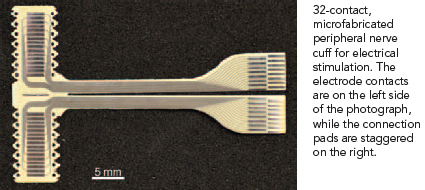Advanced Platform Technology Center
Thin Film, High-Density Peripheral Nerve Cuffs
A microfabricated, mechanically-flexible, high-density peripheral nerve cuff is being developed to improve nerve stimulation selectivity and functional control for motor and sensory applications. In this device, high- density conductive features are formed on a flexible liquid crystal polymer (LCP) substrate using photolithography and thin-film deposition, which are part of the microfabrication technology. The cuff materials and design were chosen to facilitate long-term device reliability in vivo.
Each microfabricated peripheral nerve cuff has 32 stimulating electrode contacts. Devices can be prepared for connection to external electronics by bonding discrete wires to individual connection contact pads, then encapsulating the bonds for electrical insulation and moisture resistance. The cuffs are folded along the centerline, and secured closed along the edge.
The high-density peripheral nerve cuffs have been used in both acute and chronic non-human primate experiments. A 32-contact LCP-based cuff implanted on the medial nerve was able to selectively activate four muscles acutely, and the cuff remained functional throughout 4 months of testing. During this time, 25 of the contacts displayed a median reduction in electrode-tissue interface impedance of 72%, indicating good biocompatibility and lack of tissue damage or excessive encapsulation. Further development of this technology for interfacing with complex neural structures like the human sciatic nerve is currently underway.

Principal Investigators: Allison Hess-Dunning, Ph.D. • Dustin Tyler, Ph.D.
Funding Agency: National Institutes of Health




















